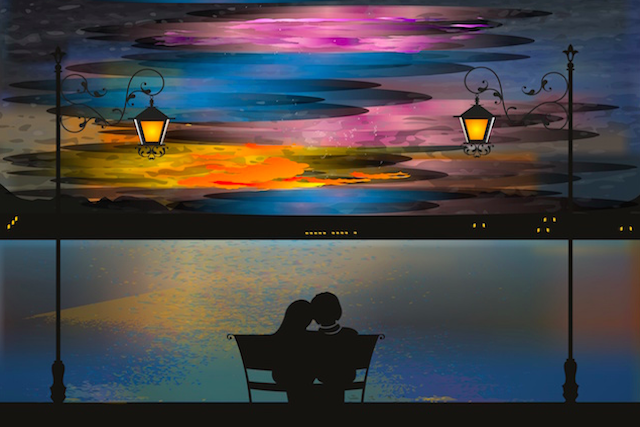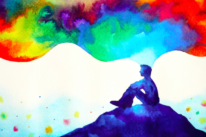
“Try not to confuse attachment with love. Attachment is about fear and dependency and has more to do with love of self than love of another.” ~Yasmin Mogahed
The feelings we get when meeting someone new are hard to understand at times. We have biopsychosocial and even spiritual responses and interactions with people we come into contact with.
We’ve all met someone and felt like we just want to be around them. They make us nervous (butterflies), we can’t think straight, we’re self-conscious, we just feel an overwhelming… pull toward them.
I have (like many before me) spent my life equating this experience with the very beginning stages of love or may even go as far as to proclaim this as “love at first sight.”
I did this because:
1. It didn’t happen often. In years and years of dating and searching for “the right one,” I only got that intense experience a handful of times. So I equated that emotional reaction with the quality of the connection.
2. I felt like any and all ambivalence disappeared from my mind and emotions. I knew, in those moments, with those people, I wanted to be around them, I needed them in my life. The questioning of ” what do I really want?” seemed to fade into oblivion. Doubt seemed to disappear from my mind.
3. I felt extremely attracted to them. Not just physically, but mentally and emotionally. It wasn’t purely lust, so it had to be more.
But what if I said, this isn’t remotely real romantic love at all? What if I said this isn’t lust either? What if I said books like Romeo and Juliet, The Notebook, Twilight, and many others alike, have gotten love completely and utterly wrong all along?
Now some of you may say, “Yeah, I knew that was all wrong.” But our culture and society were built on this deeply passionate idea of love and marriage—after all, they go together like a horse and carriage.
Our subconscious minds have been programmed to want that kind of big love, that kind of dedication, that kind of commitment. The kind that would play out like, you know, the movies.
I had this revelation recently after meeting someone and being overtaken by these emotions, for the first time in a while. I immediately went to the idea that maybe she is the one, maybe this is it. I couldn’t think straight. I couldn’t focus. I just wanted to be with her. I just wanted to be close to her.
Then I realized something quickly, while in the throes of my serendipitous fairy tale encounter: This was out of character for me at this point in my life.
I felt I couldn’t be myself. I felt like I was out of control. My confidence was muddied by nerves. I felt like I had no say in what was happening between us and what was happening inside of me. Something else took over. I knew it wasn’t purely lust and I knew, intuitively, it wasn’t what love should feel like. So what was it?
After years of growth and work, I knew one thing for sure: Balance is the secret to life. So feeling incredibly unbalanced was a red flag to me. I dug deeper. I thought back to my training as a counselor, the presentations I had given on attachment theory, and the digging I had done on my own attachment schemas.
And I realized when I quieted all of those seemingly out of control, but elated feelings, the emotion that came to the forefront was, anxiety. Pure anxiety.
I thought back to every relationship or encounter that made me feel that way, and in an effort to get to the bottom of this, I desperately asked my higher self what they had in common—and it was clear right away.
They all ran away at some point. But to be more accurate, they were all emotionally and psychologically ambivalent or wave-like in their attachment orientation. This meaning, in the context of ambivalence, they went back and forth between being emotionally available and unavailable. Sure of what they want, then unsure and pull away.
Psychological ambivalence is defined as a state of having simultaneous conflicting reactions, beliefs, or feelings toward some object.
Attachment theory is far too in depth to dive into in this article, but in short: We all develop attachment patterns stemming from childhood relationships with our caregivers, and they are ever evolving throughout our teenage and adult years as we go head first through friendships and romantic relationships.
Wave-like tendencies, in regards to attachment, are typically characterized by swaying back and forth from anxiety to ambivalent states.
So here is what happened to me: Every time I met a beautiful and intriguing woman who radiated unavailability, my teenage, insecure, anxious self forced its way to the surface from the deepest caverns of my psyche.
This strong, out-of-control feeling I associated with love was just my own wave-like attachment schema thrown full throttle into anxiety mode.
On the surface, these relationships and connections felt right and felt amazing for me because my own tortured ambivalent nature seemed to fade away, and the intense energy taking place during this dynamic essentially acted like a high. But, on a deeper level, I felt utterly rooted and anchored in anxiety.
It was deceiving. I knew what books and movies portrayed true love and soul mates to be, and my brain automatically associated these strong emotions and interactions with those narratives.
From Victim of Love, to Empowered Co-Creator of Love
I realized that real true love is a choice; it isn’t something that happens to us or triggers us. At the heart of empowerment is in fact choice. When we choose to have romantic relationships with the people that balance us, we are in control and empowered enough to choose and co-create, with that person, what that relationship will ultimately be.
We can alchemize and create relationship dynamics such as passion, dedication, and unconditional love—all of the fairy tale cues we yearn for. All accomplished by setting the intention to have that type of relationship and backing it up with actions that align with those intentions. But it must start from a space of feeling balanced in our love interests energy and presence.
In this moment of clarity I was able to realize literature and society had it all wrong. I had it all wrong. Big romantic love isn’t this overpowering energetic force that takes us over and sweeps us off of our feet. It is something we intentionally choose to co-create, from a balanced place—with a partner who draws feelings of peace from within us, not anxiety or fear, and a partner we can be our most authentic self with.
So How Do You Make The Shift and Create Healthier Romantic Relationships?
1. Understand your attachment schema and piece your own patterns together.
There are plenty of books out there, the most helpful and well-rounded of them being Your Brain on Love, by Stan Tatkin.
2. Remember, awareness is the first step.
It won’t stop you from feeling those intense emotions when you are around someone who triggers your attachment schemas, but it will empower you to make healthier choices about what role those people do or don’t play in your life. We have been conditioned on multiple levels to seek overwhelming love; it isn’t a habit we can break overnight.
3. Continue to become more aware, and heal your wounds any way you can.
Re-write the stories you’ve told yourself about what love is and what love is not that have held you back from having the type of relationship you really want. It takes time to reprogram the narrative and build real love from a balanced place, without more self-sabotage.
4. Balanced romantic relationships can start in a multitude of ways, but friendship seems to be the most naturally balanced place to start from.
This doesn’t mean force friends first, in an inorganic way; it just means listen and pay attention to how you feel when you are with that person.
5. Notice when you feel inner peace, joy, authenticity, vulnerability, and acceptance when in the presence of someone.
Those are the sentiments and emotions felt when rooted in balance. Anxiety (butterflies), fear (please don’t leave me), an anxious need to be with someone, and feeling like you need to be something or someone you aren’t—those are the biggest indicators that you are not coming from a balanced place.
About Jeremy Scott Lambert
Jeremy Scott Lambert is a Coach + Psychotherapist that works with couples and individuals all over the world. He has a passion for helping people create conscious relationships and their best lives. Check him out at JeremyScottLambert.com.













 Though I run this site, it is not mine. It's ours. It's not about me. It's about us. Your stories and your wisdom are just as meaningful as mine.
Though I run this site, it is not mine. It's ours. It's not about me. It's about us. Your stories and your wisdom are just as meaningful as mine. 